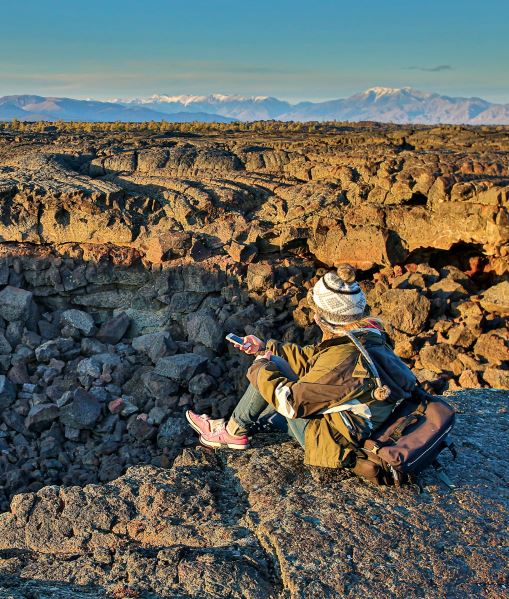 In the summer of 2008, my daughter tried her hand at golf. I did my best to tell her that for starters, we were going to play the Short Course, not the Big Course.
In the summer of 2008, my daughter tried her hand at golf. I did my best to tell her that for starters, we were going to play the Short Course, not the Big Course.
Local players of all skill levels know the reference here. The Short Course is a quaint, 5-hole mini circuit adjacent to Sand Creek Golf Course—a bonafide 18-hole championship layout (more or less) just southeast of Idaho Falls.
My kid knew better than to tantrum, but she still did her best to convince me to always play the Big Course. It wasn’t even about the golf, really. Mostly it was about the circuitous adventure that came along with it.
Flash-forward a couple years and we found ourselves on a different kind of adventure: a day trip to Craters of the Moon National Monument & Preserve (COTM). On our way, just 20 miles west of town on U.S. Highway 20, we spotted a nondescript sign for “Lava Trails.” That got my attention just enough for a hard left into one of our area’s most interesting geologic gems—Hell’s Half Acre.
For lava-bound adventure-seekers, welcome to nature's Short Course.
It may not have the rich history, storied natural structures and NASA-level attention paid to COTM, but according to the U.S. Dept. of the Interior’s Bureau of Land Management, Hell’s Half Acre does have the dual distinction of “National Natural Landmark” (NNL) and “Wilderness Study Area” (WSA).
If you have the motivation and fortitude to explore it, its unique lava trail system is open to non-motorized recreation activities only.
“Trail system” is actually a relative term here. For reasonable access and safe-traversing (a constant factor for my age and now-limited mobility), a better bet is to enter the 150 square-mile tract from the I-15 rest stop exit between Idaho Falls and Blackfoot. Facilities abound here, including paved, wheelchair accessible paths, safety rails, picnic tables and lots of informative signage.
On the west side, however, expect a far more primitive experience. There are no actual trails to speak of. Your navigational keys are akin to the beacons of Gondor from Lord of the Rings—marked not by fires, but by the color-coded tops of 8-foot tall poles. A short loop around the lavascape is marked in blue; a longer one is marked in red.
Fair warning here: It’s not a walk in the park. In fact, it’s not like any backcountry hike you’d ever experience elsewhere—not even at COTM. The challenge is straightforward: Just carefully amble and rock-hop towards the first pole, get your bearings, then amble and rock-hop to the next.
Immersion in this unique environment can be breathtaking and full of photo-ops. Our favorite features are the deep crevices, some of which harbor a cool, rich micro-climate filled with colorful lichens, moss, ferns and other vegetation.
We’ve rarely encountered wildlife out on the short (blue pole) loop, but the area has more of it than you’d expect. Mule deer frequent the lava fields, as do antelope, rabbits, bobcats, coyotes, foxes, rattlesnakes and various birds of prey.
As for the terrain, its volcanic features are made up of a porous mix of domes, pits, lava tubes and caves. The lava rock itself can be extremely sharp with its glassy fragments. (For that reason alone, you may want to wear gloves to save your hands a world of hurt if you end up taking a spill. Trust me—been there, done that.)
The remnants of the ancient flows come in two distinct flavors: A’a (ah-ah) and pahoehoe (pa-hoy-hoy). The former is sharp, rough and chunky. The latter is ropey and smooth. A third type of ground feature is lava rock at all but rather a lack of it.
Any spare patch of soil and vegetation that is NOT covered by lava is called kipuka. That’s Hawaiian for 'window in the lava.
Who knows—If a visit to Hell’s Half Acre sparks your interest, now you might just be primed for the “Big Course” at Craters of the Moon! Either way, this adventure west of town definitely makes for an afternoon well spent.
For more details, be sure to check out the BLM page at blm.gov/visit. From there you’ll find links and maps to the study area as well as the trail system.